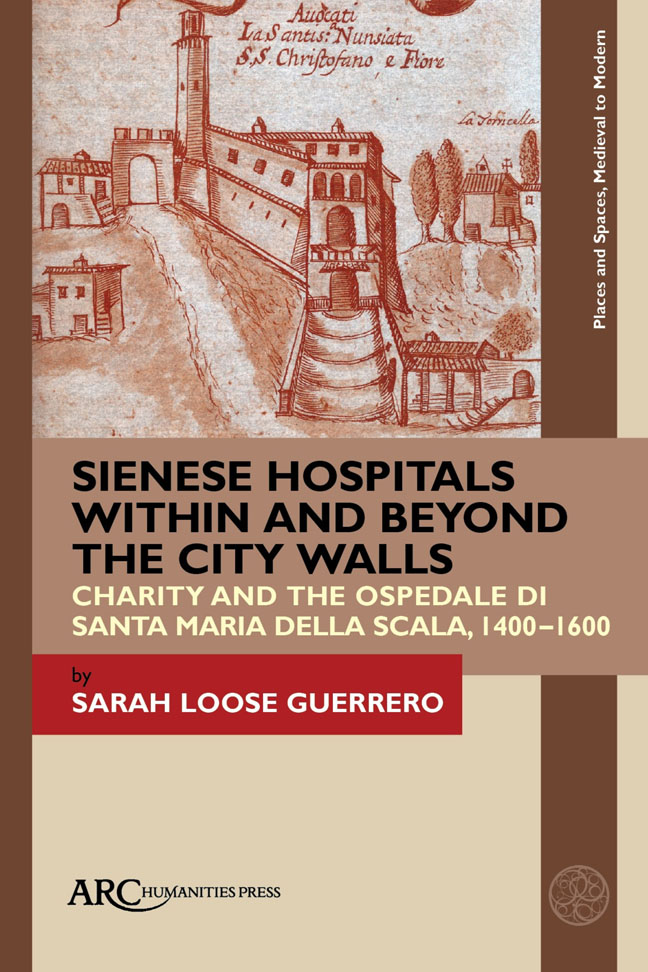 Sienese Hospitals within and beyond the City Walls
Sienese Hospitals within and beyond the City Walls Book contents
- Frontmatter
- Contents
- List of Illustrations
- Acknowledgements
- Introduction
- 1 A Most Pious House: Charity and Power in the City
- 2 An Extended Family: Rural Charity and Power in the Contado
- 3 Spaces of Charity Beyond Siena's Borders: The Spedali di Fuori
- 4 Charity and Power in Crisis: Shifting Dynamics
- 5 Power in the Granducato: Santa Maria della Scala and the Medici Grand Dukes
- Epilogue: Santa Maria della Scala's Spaces of Charity after 1600
- Select Bibliography
- Index
5 - Power in the Granducato: Santa Maria della Scala and the Medici Grand Dukes
Published online by Cambridge University Press: 17 February 2024
- Frontmatter
- Contents
- List of Illustrations
- Acknowledgements
- Introduction
- 1 A Most Pious House: Charity and Power in the City
- 2 An Extended Family: Rural Charity and Power in the Contado
- 3 Spaces of Charity Beyond Siena's Borders: The Spedali di Fuori
- 4 Charity and Power in Crisis: Shifting Dynamics
- 5 Power in the Granducato: Santa Maria della Scala and the Medici Grand Dukes
- Epilogue: Santa Maria della Scala's Spaces of Charity after 1600
- Select Bibliography
- Index
Summary
Following the crisis and disruptions of war, Siena and its subject territory confronted a new round of challenges as Siena became part of the Tuscan state. This chapter seeks to examine the interactions and negotiations which shaped the new geography of power between Siena and the larger territorial state: the Grand Duchy of Tuscany. Previous scholarship has examined the post-war period largely from a political and military perspective, taking into account various social, cultural, and religious issues. The common narrative treats the period as a time of decline, while also agreeing that despite losing political independence, the Sienese maintained a good deal of autonomy and a distinct culture and identity. However, there is much work to be done in detailing the processes underlying this narrative, including the need for a more thorough understanding of the distribution of power within the state and the ways in which negotiations between the Medici and Sienese elite produced a system where the centre maintained control while allowing a degree of autonomy. One useful way to approach such a study is to examine various sites of power and the ways in which power was manifested. As demonstrated in the previous chapters, Santa Maria della Scala was more than just a provider of charity and poor relief, it was also a key civic institution and a source of power. The hospital and its network thus provide an opportunity to look closely at the ways in which both the Medici and the Sienese elite participated in shap ing a new economy of power. The case of Santa Maria della Scala shows how the Medici exploited divisions and promoted competition among the Sienese elite to consolidate central authority, using offices such as the rectorship of the hospital as means to build patronage ties. Siena's city government also took action to retain control of the hospital, creating a dynamic in which Santa Maria della Scala's administrators often had to choose between two competing authorities.
Through a series of negotiations that included the reform of the hospital and its resistance, at varying times, to both the Medici and the city government, a new distribution of power was achieved by the end of the sixteenth century. The Medici grand dukes successfully centralized control of Santa Maria della Scala and used the hospital as an arm of the Tuscan state, but the city government retained the ability to participate in hospital administration.
- Type
- Chapter
- Information
- Sienese Hospitals within and beyond the City WallsCharity and the Ospedale di Santa Maria della Scala, 1400-1600, pp. 135 - 170Publisher: Amsterdam University PressPrint publication year: 2023
